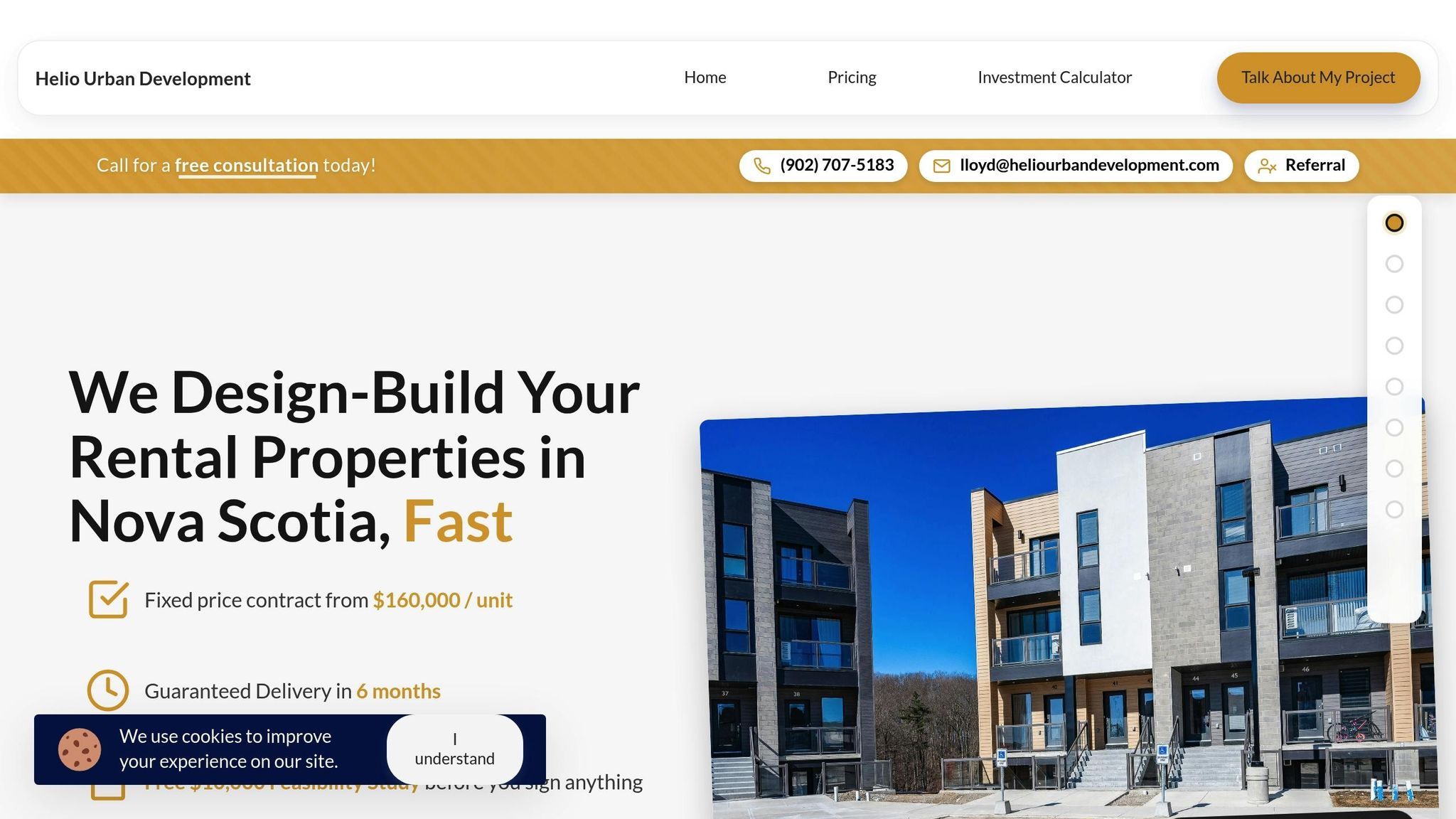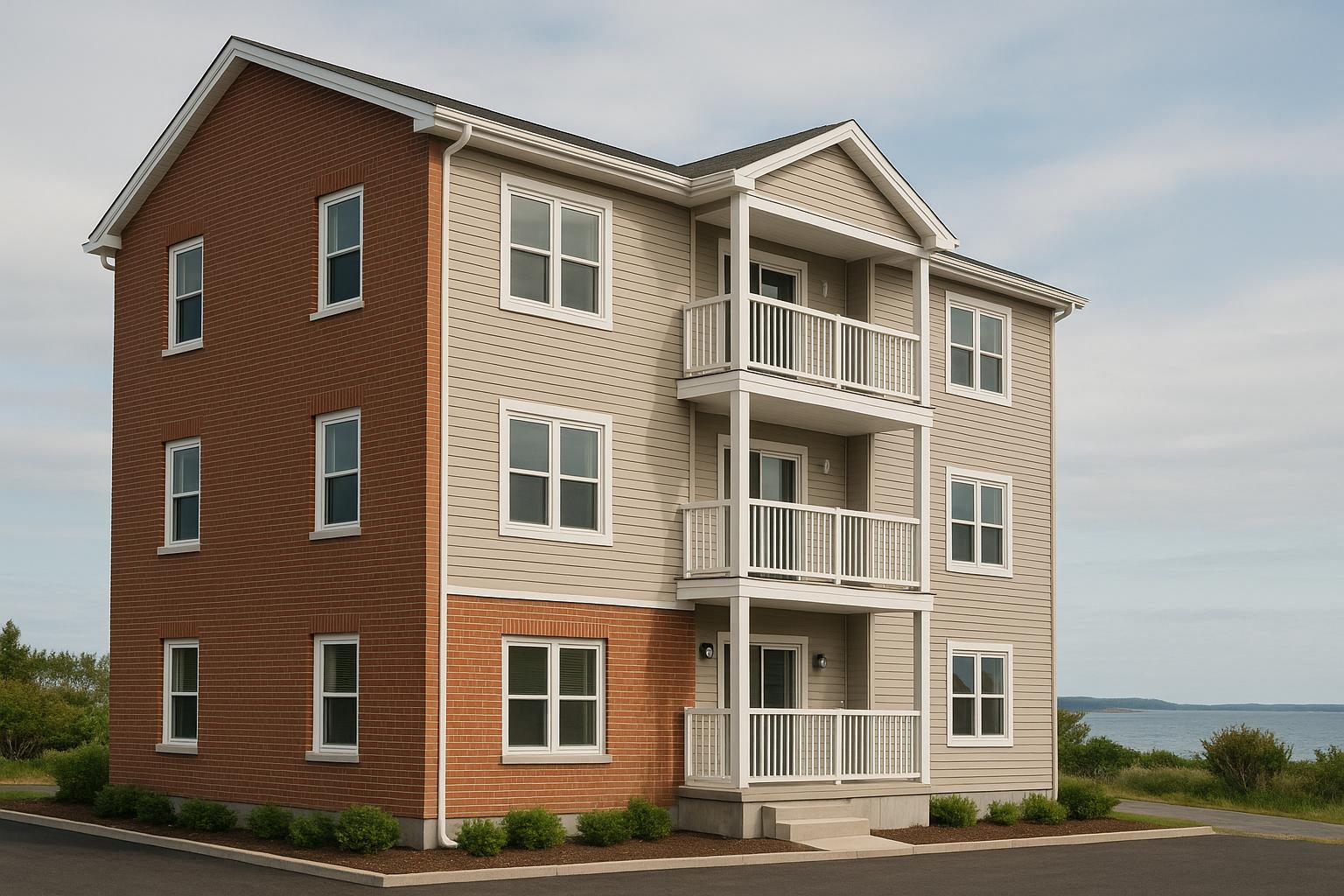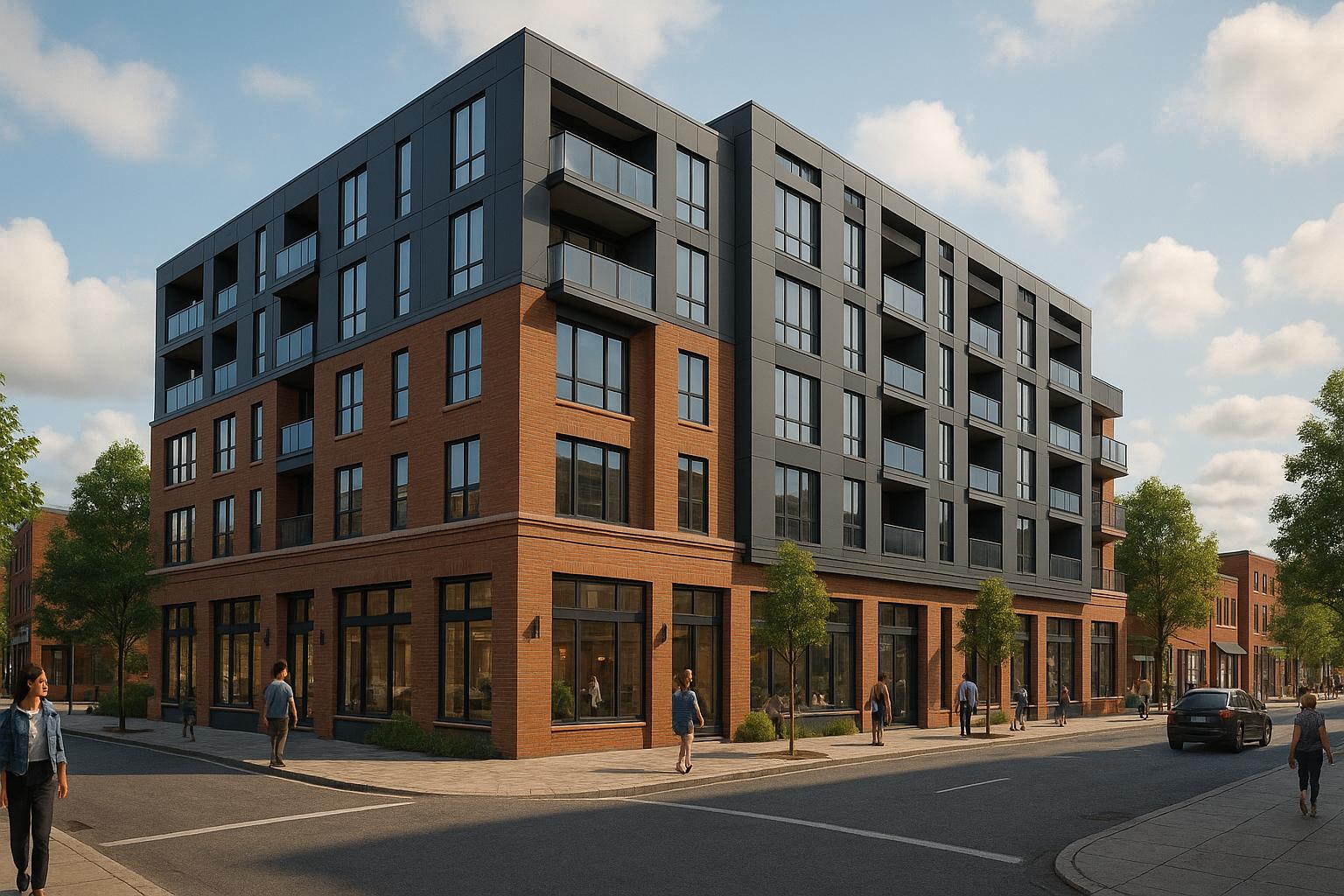HR-1 zoning in Halifax supports mid-rise housing (3–6 storeys) in areas like Downtown Dartmouth, aiming to balance development with neighbourhood harmony. Key features include:
- Height limits of 14–20 metres, with a streetwall cap of 11.0 metres.
- Flexible parking (1 space per 3 units) and streamlined approval processes.
- Setbacks and stepbacks to ensure privacy, sunlight, and reduced noise for adjacent properties.
- Transition rules for properties next to Established Residential zones, including larger setbacks (6.0 metres) and stepbacks (6 metres above the 2nd–4th storey).
Helio Urban Development simplifies HR-1 projects with fixed pricing, a 6-month timeline, and zoning compliance. Their packages range from $160,000–$200,000 per unit, offering options for energy efficiency and immediate rental readiness. With 95% financing available under CMHC MLI Select, property owners can expect strong returns and a smooth building process.
Neighbour Transition Requirements Under HR-1 Zoning
Setbacks, Stepbacks, and Separation Distance
Setbacks, stepbacks, and separation distances play a key role in balancing the needs of neighbours while maximizing the buildable area on HR-1 zoned properties.
Setbacks refer to the minimum distance a building must maintain from property lines. Under HR-1 zoning rules, buildings must be set back 3.0 metres from the front or flanking street[2]. However, for properties next to an Established Residential or PCF zone, setbacks increase to 6.0 metres for both the side and rear property lines[1][2].
Stepbacks are vertical recesses applied to buildings that exceed specific height limits. For example, after a building surpasses the 11.0-metre streetwall height, a stepback of 2 metres is required for mid-rise buildings, while tall mid-rise buildings need a 3-metre stepback[2]. If the property borders an Established Residential zone, a larger stepback of 6 metres is required above the 2nd, 3rd, or 4th storey[2]. These stepbacks help create distinct building profiles while maintaining neighbour-friendly designs.
Separation distances come into effect when different portions of a building are located on the same lot. If a building is set back at least 8 metres, no additional side separation is needed. However, for buildings with multiple sections above grade, a 4-metre separation is required below the streetwall, and a 6-metre separation is mandated above the streetwall for mid-rise structures[2].
Height and Use Restrictions in Transition Zones
Height restrictions in HR-1 transition zones are designed to create a smoother visual and physical connection between higher-density developments and neighbouring lower-density areas. The 11.0-metre streetwall height limit ensures a gradual transition[1]. Beyond this height, stepbacks are required to reduce the visual impact of upper floors.
For properties next to Established Residential zones, the 6-metre stepback above the 2nd, 3rd, or 4th storey results in a sloped building profile. This design minimizes shadowing on nearby yards and helps maintain privacy for adjacent homes[2]. While mixed-use developments are allowed, their design must align with the residential character of the area.
What These Rules Mean for Property Owners
These zoning rules directly influence how properties are designed and built, often restricting the buildable area and shaping the overall structure. For instance, in Established Residential zones, larger setbacks reduce the available building footprint, pushing architects to find creative ways to maximize interior space.
Stepback requirements must be factored into the design process from the start. For properties adjacent to Established Residential zones, the 6-metre stepback above the 2nd, 3rd, or 4th storey affects not only the building’s exterior profile but also the layout of individual units[2].
By planning around these requirements early, design teams can address potential concerns like shadowing and privacy. This approach helps ease neighbour worries and can lead to smoother project approvals. Ultimately, these detailed guidelines encourage thoughtful planning to meet zoning compliance while making the best use of the space.
| Transition Requirement | Standard HR-1 | Adjacent to ER/PCF Zone | Impact on Design |
|---|---|---|---|
| Side Yard Setback | 2.5 metres | 6.0 metres | Reduced building width |
| Rear Yard Setback | 3.0 metres | 6.0 metres | Smaller building footprint |
| Stepback Above Streetwall | 2–3 metres | 6 metres above 2nd–4th storey | Terraced upper floors |
| Front/Flanking Setback | 3.0 metres | 3.0 metres | Consistent street presence |
Design and Construction Strategies for HR-1 Compliance
Site Planning Best Practices
Effective site planning is all about making the most of your lot while respecting setback and stepback requirements. Properties next to Established Residential areas often need larger setbacks, which can shrink the usable building footprint compared to other HR-1 developments. This means careful planning is essential.
One way to maximize space is by aligning the building’s longest side parallel to the street. This approach helps you make the most of the available footprint while staying within setback limits. It's especially useful for properties where the 6-metre stepback applies above the 2nd, 3rd, or 4th storey next to Established Residential zones.
Parking and access should also be part of the early planning stages. Underground or structured parking can free up ground-level space for landscaping or shared amenities, which helps maintain good relations with the neighbourhood. If surface parking is necessary, placing it in less visible areas can keep the streetscape looking clean and cohesive.
Finally, a well-thought-out building envelope is key. Instead of trying to fit a pre-designed structure into zoning constraints, design within the maximum allowable space from the start. This not only simplifies the process but also helps create a building that blends more naturally with its surroundings.
Building Design for Neighbour-Friendly Buildings
Good design isn’t just about meeting zoning rules - it’s about creating buildings that add to the neighbourhood’s character. Stepbacks, for example, don’t have to be just a zoning requirement. With stepped massing and thoughtful material choices, these can be turned into terraces that look great and provide outdoor space for upper-floor units.
Materials like brick, stone, and high-quality siding work particularly well in Halifax’s established neighbourhoods. Mixing materials between floors or sections of the building can also break up the visual bulk, making the structure feel less imposing.
Privacy and natural light are another balancing act. Thoughtfully placed windows and landscaping can achieve both. Trees and shrubs along property lines not only soften the building’s edges but also help it blend into the existing streetscape.
Energy-efficient features like triple-pane windows and proper insulation do more than just cut operating costs - they also reduce noise transmission. A well-designed building envelope keeps interiors comfortable year-round and ensures mechanical systems like HVAC units are discreetly integrated, avoiding visual and noise disturbances.
Construction Tips for Noise and Energy Efficiency
Smart construction practices can make all the difference in minimizing disruptions and achieving long-term energy performance. Scheduling noisy tasks during approved hours and using sound-dampening materials can go a long way toward maintaining good neighbour relations. Sharing construction schedules with nearby residents is another proactive step that helps avoid unnecessary tension.
Inside the building, concrete floors with sound-dampening layers reduce noise transfer between units and to adjacent properties. Quality insulation in walls and ceilings not only improves thermal performance but also dampens sound.
Advanced framing techniques help improve energy efficiency while speeding up construction. These methods reduce thermal bridging and make better use of materials, which translates to improved insulation and less waste.
For high-performance building envelopes, attention to detail is critical. Proper air sealing and continuous insulation, especially around windows and doors, prevent energy loss and moisture issues. These strategies are particularly important for buildings aiming to meet CMHC MLI Select standards, which require designs to be 40% more energy efficient than the standard building code.
Mechanical systems also play a big role in both energy efficiency and noise control. Careful placement of heat pumps, ductwork, and ventilation systems can minimize noise while ensuring optimal performance. Selecting the right equipment and installing it correctly prevents long-term issues with mechanical noise.
During construction, quality control is essential to ensure the finished building meets design goals. Regular inspections of insulation, air sealing, and mechanical systems help catch potential issues early, saving time and money down the line. Professional engineering oversight can be especially valuable for spotting problems before they escalate.
Lastly, the construction process itself matters. Integrated construction teams that coordinate from the outset tend to deliver better results than traditional approaches where contractors work independently. This kind of collaboration is especially important for complex projects that need to incorporate HR-1 zoning requirements like stepbacks and varied massing.
Integrated Design-Build vs. Standard Construction Methods
Key Differences Between Integrated and Standard Models
When it comes to construction, the method chosen can make or break a project's success. Traditional construction requires property owners to juggle multiple contracts with various independent professionals. This fragmented approach often leads to poor coordination, as each professional works in isolation, leaving property owners stuck trying to bridge communication gaps between teams that rarely, if ever, collaborate directly.
Integrated design-build changes the game by offering a streamlined alternative. All professionals operate under one company, ensuring unified accountability. Instead of managing several contracts, property owners sign a single agreement that covers everything - from planning to the final build. This approach eliminates the blame game that often arises in traditional projects when issues occur.
A major distinction lies in pricing models. Traditional construction typically uses cost-plus pricing, where property owners pay for materials, labour, and a markup - without knowing the final cost until the project is complete. This often results in overruns of 30–60% due to fragmented accountability. In contrast, integrated builders like Helio Urban Development offer fixed pricing, such as $160,000 per unit, locked in before construction begins. This transparency allows property owners to plan finances and calculate returns with confidence from day one.
Timelines are another area where integrated models shine. Traditional projects often stretch over 12–18 months, whereas integrated teams coordinate all trades from the outset, leveraging advanced scheduling to complete projects in just six months. This efficiency reduces delays and keeps the project on track.
Benefits of the Integrated Approach
One of the immediate advantages of integrated design-build is the elimination of coordination inefficiencies. Traditional methods often result in property owners losing an average of $47,000 per project due to duplicated efforts, scheduling conflicts, and communication breakdowns between separate contractors. By working as a unified team, integrated builders remove this waste entirely.
Accountability is another area where integrated models excel. In traditional builds, disputes are common - architects blaming engineers, engineers blaming contractors, and so on - leaving property owners stuck mediating conflicts while their project stalls. With integrated design-build, there is one point of accountability for all issues, ensuring smoother problem resolution.
Guaranteed timelines with financial penalties protect property owners from income loss caused by delays. For example, a six-unit building generating $1,950 per unit per month loses $11,700 in rental income for every month construction is delayed. With integrated design-build, property owners can rely on timely project completion. Companies like Helio even offer penalties of up to $1,000 per day for delays, ensuring their scheduling commitments are met.
Quality control is also significantly improved. Instead of relying on various contractors to adhere to consistent standards, integrated teams enforce uniform quality measures across all trades. Professional engineers inspect the work five times during construction, and property owners can choose their own final inspector for added peace of mind.
Another standout feature is daily transparency. Property owners receive photo updates and access to real-time project portals, eliminating the need for constant site visits. In contrast, traditional builds often leave owners in the dark between sporadic contractor updates.
Comparison Table: Integrated vs. Standard Construction
Here's a side-by-side comparison to highlight the key differences:
| Aspect | Integrated Design-Build | Standard Construction |
|---|---|---|
| Contracts | Single unified contract | 6+ separate contracts to manage |
| Accountability | Unified responsibility | Finger-pointing between trades |
| Pricing | Fixed price guaranteed | Cost-plus with 30–60% overruns |
| Timeline | 6 months guaranteed | 12–18 months typical |
| Coordination | Built-in team alignment | Property owner manages conflicts |
| Quality Control | 5 P.Eng inspections + owner choice | Varies by contractor |
| Communication | Daily photo updates | Sporadic contractor check-ins |
| Penalties | Up to $1,000/day for delays | No timeline guarantees |
| Warranty | 2-year comprehensive coverage | Separate warranties per trade |
For example, in a typical fourplex, every month of delay results in $7,800 in lost rental income - revenue that can never be recovered, even after construction is complete.
Risk management is another area where integrated approaches excel. Fixed pricing, timeline guarantees, and comprehensive warranties shift risks away from property owners and onto the builder. By comparison, traditional construction leaves property owners vulnerable to cost overruns, delays, and quality issues across multiple contractors. Integrated design-build absorbs these risks under a single, cohesive agreement, providing peace of mind and predictable outcomes.
sbb-itb-16b8a48
Building Under HR-1 Zoning with Helio Urban Development

Step-by-Step Process with Helio
Helio Urban Development has crafted a smooth, efficient process for HR-1 projects, leveraging its integrated design-build expertise. Their five-phase approach begins with a site analysis, where Helio’s planning team evaluates your property against HR-1 zoning requirements. This includes assessing transition zones with neighbouring properties and calculating setbacks to ensure compliance.
In the design phase, architects and engineers collaborate to create plans that harmonize with surrounding properties. For sites next to ER zones, they focus on maximizing unit counts while adhering to the 6.0-metre setbacks and stepbacks required above the second storey.
Next comes permit coordination, where Helio takes care of municipal approvals, ensuring zoning compliance and managing building permits. They also handle any necessary consultations with neighbours, keeping property owners informed throughout the process.
Once permits are secured, construction begins under a fixed-price agreement with a strict schedule to avoid delays. Helio’s scheduling system ensures all trades are coordinated from day one. Owners can monitor progress through a real-time project portal, receiving daily photo updates.
The final phase includes five separate engineer inspections, plus a review by the owner’s chosen inspector. This triple-verification process ensures high-quality results, all within a six-month construction timeline.
Helio's Construction Packages and ROI Metrics
Helio offers three tailored construction packages to meet different property owner goals.
The Standard Construction package, priced at $160,000 per unit, is designed for those aiming to maximize returns. It includes features like ductless heat pumps, triple-pane windows, quartz countertops, and engineered hardwood flooring. With this package, property owners can expect monthly rents of $1,950–$2,100 per unit, yielding an annual ROI of 12–20%. A minimum project size of four units means construction costs start at $640,000, which must be financed by the property owner.
For those seeking better financing options, the CMHC MLI Select Construction package costs $200,000 per unit. These buildings are 40% more energy-efficient than standard code requirements, qualifying for 95% financing with only a 5% down payment and 50-year amortization. This financing structure provides a 20:1 leverage ratio, allowing owners to build more units with the same capital while maintaining positive cash flow from day one. Although the upfront cost is higher, the financing terms often lead to stronger overall returns for owners with limited capital.
The Premium Rental Ready Package adds $15,000 per unit to either base package. It includes Energy Star appliances, smart home technology, window blinds, and bathroom accessories. This option allows property owners to start collecting rent immediately, skipping the typical 60-day furnishing period. Helio’s bulk purchasing saves over $3,000 per unit compared to retail prices.
| Package | Cost Per Unit | Key Features | Target ROI | Financing |
|---|---|---|---|---|
| Standard | $160,000 | Ductless heat pumps, triple-pane windows, quartz counters | 12–20% | Traditional loans |
| CMHC MLI Select | $200,000 | 40% more energy-efficient, CMHC-qualified | 12–20%+ | 95% financing, 50-year amortization |
| Premium Rental Ready | +$15,000 | Appliances, smart tech, move-in ready | Immediate rent collection | Add to any base package |
These packages ensure predictable outcomes for HR-1 projects while meeting zoning and neighbour transition requirements.
Examples of Completed HR-1 Projects
Helio currently has 31 units under construction across Nova Scotia, with 131 more in the planning stages. These projects serve property owners within a 90-minute radius of Halifax. While specific project details weren’t available, Helio’s track record highlights consistent delivery of HR-1 builds that balance zoning compliance with profitability.
One standout feature of Helio’s approach is their zero-overrun record. By locking in pricing before construction begins, they eliminate the budget surprises that often disrupt traditional builds. Property owners also benefit from daily updates via project portals, offering transparency without the need for constant site visits.
Helio’s efficient process cuts typical construction timelines from 12–18 months down to just six months, all while maintaining high-quality standards verified through multiple engineering inspections. With Halifax rental rates of $1,950–$2,100 per unit, property owners can confidently calculate returns before breaking ground.
The combination of fixed pricing, guaranteed timelines, and compliance with neighbour-friendly designs makes Helio’s HR-1 projects a reliable investment option for property owners.
Conclusion: HR-1 Zoning Success with Helio
HR-1 zoning turns neighbour transition requirements into opportunities for thoughtful design, ensuring that compliance not only smooths the approval process but also supports long-term profitability. Forward-thinking property owners recognize the potential in these design elements to create rental properties that integrate seamlessly into their communities.
The most successful HR-1 projects show that compliance and profitability can work hand in hand. Setback and stepback requirements do more than just protect neighbouring properties - they allow new developments to blend into their surroundings, reducing resistance and accelerating approvals. This balance between meeting regulations and achieving financial goals is at the heart of Helio’s approach.
Helio Urban Development eliminates the headaches of traditional project coordination. Instead of juggling multiple teams - planners, architects, engineers, contractors - which often leads to budget overruns of 30–60%, Helio offers a fully integrated solution. Their fixed-price construction model guarantees completion within six months, cutting through the inefficiencies of multi-contract chaos.
This streamlined, fixed-price model ensures predictable costs and strong returns while fully meeting neighbour transition requirements. For property owners looking to maximize their investment, Helio’s CMHC MLI Select package offers 95% financing with a 50-year amortization, enabling positive cash flow from the start.
Lloyd Liu’s personal guarantee reflects Helio’s dedication to staying on budget and on schedule. After experiencing the delays and cost overruns common in traditional builds, Liu developed a system focused on precision and execution, ensuring no surprises along the way.
For Halifax property owners looking to make the most of HR-1 zoning, the solution is clear: an integrated approach that views neighbour transitions as opportunities rather than obstacles. By turning regulatory requirements into design advantages, Helio creates projects that benefit both communities and investors. With Helio’s efficient model, property owners can confidently move forward with developments that deliver both value and profitability.
FAQs
How does HR-1 zoning in Halifax support growth while respecting neighbourhood character?
HR-1 zoning in Halifax permits the construction of mid-rise apartment buildings (3–6 storeys), townhouses, and stacked townhouses, while ensuring a smooth blend with nearby low-rise residential areas. This zoning approach carefully limits high-density developments and includes requirements like amenity spaces (typically 5 square metres per unit) to strike a balance between urban growth and quality of life.
By restricting potentially disruptive activities, such as certain commercial uses on corner lots, HR-1 zoning helps maintain the character of existing neighbourhoods. This thoughtful planning approach supports growth that respects community values and promotes neighbour-friendly development.
What are the advantages of using an integrated design-build approach for HR-1 apartment projects in Halifax?
Choosing a design-build approach for HR-1 apartment projects in Halifax comes with several clear benefits. By merging the design and construction phases into one cohesive process, projects can move along faster and more cost-effectively. This method encourages stronger collaboration and communication among architects, engineers, and builders, leading to smoother workflows and fewer unexpected delays.
For property owners, this model offers better control over budgets and more predictable timelines - two critical factors when dealing with Halifax's HR-1 zoning requirements. It simplifies compliance with rules like neighbour transition guidelines, cutting down on uncertainty. The result? A more straightforward and less stressful building process for those investing in these projects.
How does Helio Urban Development’s fixed pricing model reduce financial risks for property owners in HR-1 zoned projects?
Helio Urban Development offers a fixed pricing model that takes the guesswork out of budgeting for property owners. With a guaranteed cost of $160,000 per unit, this approach eliminates the risk of unexpected expenses, giving property owners clear financial boundaries and reducing stress.
On top of that, their 6-month guaranteed completion timeline ensures projects stay on track. This predictable schedule allows property owners to plan their investments with confidence, avoiding costly delays. Together, these guarantees provide both cost and timeline reliability, making HR-1 projects smoother and more profitable.



